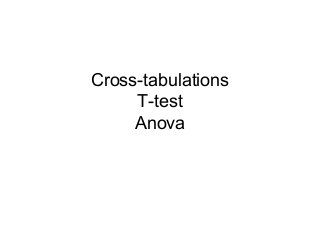
Cross tabulations
- 4. Select Variables Layer: Gender, Display: Bar chart
- 7. Bar Chart
- 8. T-Test • The t test for independent means is used to compare means derived from unrelated (uncorrelated) samples. • For example: We have 2 independent groups here, women and men. To test a hypothesis regarding the differences between the 2 groups, we can use a t-test for independent means.
- 10. Explanation to Table 4 (see previous slide) http://roseproject.no/network/countries/iran/2012_Sarjou_et_al_ROSE_Iranian_students.pdf
- 11. Another example case for T-test grouping • Example. Patients with high blood pressure are randomly assigned to a placebo group and a treatment group. The placebo subjects receive an inactive pill, and the treatment subjects receive a new drug that is expected to lower blood pressure. After the subjects are treated for two months, the two-sample t test is used to compare the average blood pressures for the placebo group and the treatment group. Each patient is measured once and belongs to one group.
- 12. One-way ANOVA • The One-Way ANOVA procedure produces a one-way analysis of variance for a quantitative dependent variable by a single factor (independent) variable. Analysis of variance is used to test the hypothesis that several means are equal. This technique is an extension of the two-sample t test. • In addition to determining that differences exist among the means, you may want to know which means differ. There are two types of tests for comparing means: a priori contrasts and post hoc tests. Contrasts are tests set up before running the experiment, and post hoc tests are run after the experiment has been conducted. You can also test for trends across categories.
- 13. Example Case • Doughnuts absorb fat in various amounts when they are cooked. An experiment is set up involving three types of fat: peanut oil, corn oil, and lard. Peanut oil and corn oil are unsaturated fats, and lard is a saturated fat. Along with determining whether the amount of fat absorbed depends on the type of fat used, you could set up an a priori contrast to determine whether the amount of fat absorption differs for saturated and unsaturated fats.
- 14. One-way ANOVA • If you don’t have pre-test and post-test data, don’t use this statistical measurement.
